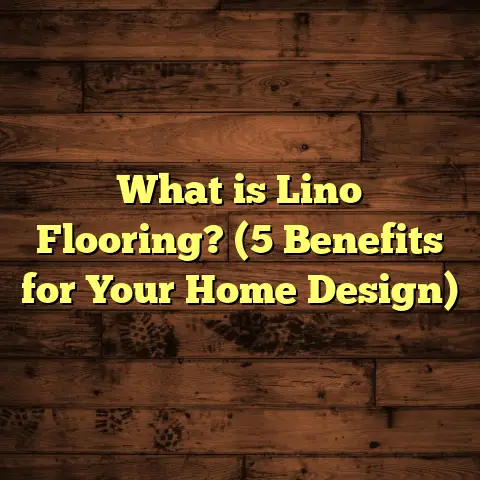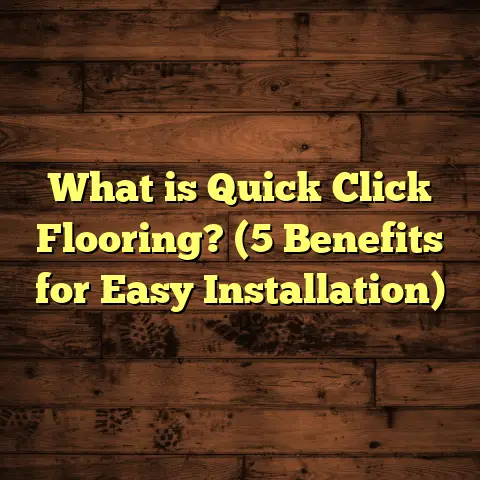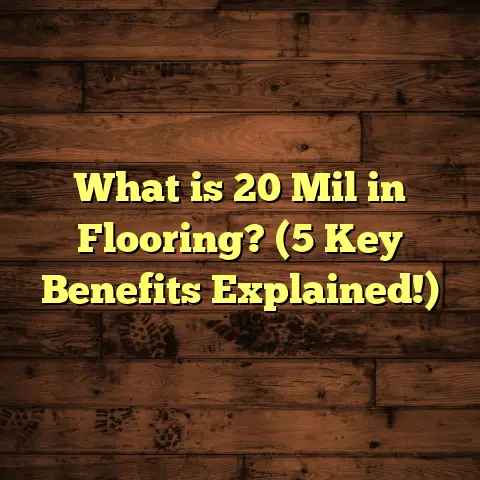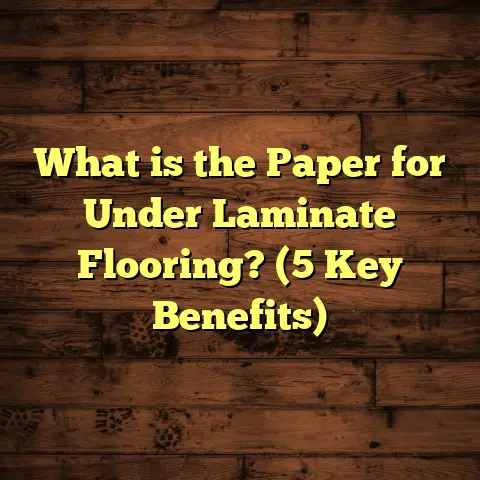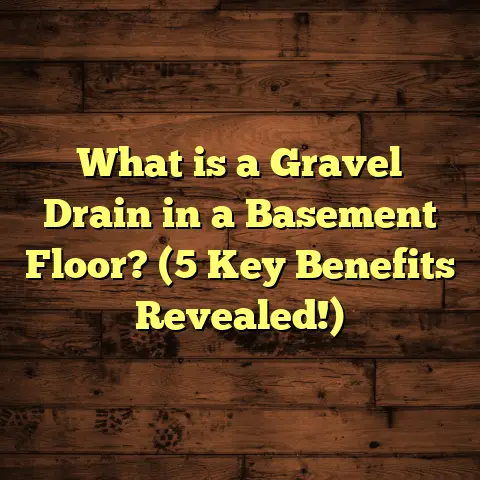What is Parquet Flooring Made Of? (5 Key Materials Explained)
I remember the first time I stepped into a room with parquet flooring. It wasn’t just any floor—it was like walking onto a piece of art. The way the wood pieces were arranged in a geometric pattern made the whole room feel warm, inviting, and unique. The light caught the wood’s grain differently at every angle, creating a subtle dance of shadows and highlights. Now, rewind to before that floor was installed: plain, dull flooring that did nothing for the space. That contrast stuck with me. It was clear that parquet flooring could completely transform a room’s character.
Over the years, as a flooring contractor, I’ve installed countless parquet floors, each with its own personality and story. Along the way, I noticed how many people get confused about what parquet flooring actually is and what materials it’s made from. That’s why I want to share everything I’ve learned about it—from the basics to more detailed insights—so you can understand what makes parquet such a special choice.
What Is Parquet Flooring?
Parquet flooring is a type of wood flooring made up of small pieces of wood arranged in distinct geometric patterns. Unlike traditional hardwood flooring, which uses long planks laid side by side, parquet uses blocks or strips of wood fitted together to form decorative designs. These patterns can range from simple squares to complex shapes like herringbone, chevron, basket weave, and more.
The name “parquet” comes from the French word parchet, meaning “small compartment of wood,” which perfectly describes how these floors are constructed from many tiny pieces rather than continuous planks.
I often hear people ask if parquet is just another type of hardwood floor. The answer is yes and no. While parquet often uses hardwood materials, it’s the way these pieces are arranged and installed that sets it apart. The craftsmanship involved in creating those intricate patterns adds an artistic layer to what might otherwise be just a floor.
Why Do People Choose Parquet Flooring?
Parquet floors aren’t just about looks—they’re about creating a sense of style and warmth that other flooring types often can’t match. Here are some reasons why parquet is so popular:
- Aesthetic appeal: The patterns give floors a decorative touch that enhances the entire room.
- Durability: When made with quality materials and installed properly, parquet floors can last decades.
- Versatility: Parquet can fit into many design styles—traditional, rustic, modern, or eclectic.
- Value: Because of its timeless appeal and craftsmanship, parquet can add value to your home.
I’ve had homeowners tell me that after installing parquet floors, their rooms feel “alive” or “more elegant.” It’s that kind of feedback that keeps me passionate about this flooring type.
1. Solid Hardwood: The Classic Choice
When people think of parquet flooring, they usually picture solid hardwood blocks arranged in beautiful patterns. Solid hardwood is exactly what it sounds like—each piece is cut from a single piece of wood.
What Species Are Commonly Used?
Hardwood species are chosen based on hardness, grain pattern, color, and availability. Some of the most popular woods for solid hardwood parquet include:
- Oak: The most common choice due to its durability and distinctive grain.
- Maple: Known for its fine grain and lighter color.
- Walnut: Darker wood with a rich brown tone.
- Cherry: Reddish hues that deepen with age.
- Mahogany: Exotic wood with reddish-brown color.
Each species has its own look and feel, so your choice will depend on your style preferences and budget.
Durability and Lifespan
One of the biggest benefits of solid hardwood parquet is longevity. Because each block is solid wood all the way through, you can sand and refinish the floor multiple times over its lifetime. This extends its lifespan to 40-60 years or more.
According to the National Wood Flooring Association (NWFA), homeowners who maintain their solid hardwood parquet floors properly see an average lifespan of around 50 years. Maintenance includes regular cleaning, avoiding excessive moisture, and refinishing every 10-15 years depending on wear.
Installation Insights
Installing solid hardwood parquet requires skill and precision. Each block must be carefully laid in the desired pattern with tight joints. The flooring is usually nailed or glued down over a subfloor.
I recall working on a historic home where the original solid hardwood parquet floor was in rough shape after 80 years. We removed damaged blocks, replaced them with matching pieces from reclaimed wood, and sanded the whole floor down. The result was stunning—a floor that looked like it had been frozen in time but renewed for modern use.
Cost Considerations
Solid hardwood parquet tends to be more expensive than other flooring options because of:
- The cost of quality hardwood.
- Skilled labor required for installation.
- Time-intensive process due to intricate patterns.
On average, solid hardwood parquet installation costs between $8 and $15 per square foot, though high-end species or custom patterns can push prices higher.
2. Engineered Wood: Stability Meets Style
Engineered wood parquet has become increasingly popular as a practical alternative to solid hardwood. It consists of multiple layers:
- A thin top layer (veneer) of real hardwood.
- Several layers of plywood or high-density fiberboard beneath.
Why Engineered?
If you live in an area with high humidity or want to install parquet in a basement or over concrete slabs, engineered wood is often the better choice.
Appearance and Feel
Since the top veneer is real wood—often 2-6 mm thick—engineered wood parquet looks very similar to solid hardwood from above. You get authentic grain patterns and textures while benefiting from improved durability.
I worked on an urban condo where engineered wood parquet was installed throughout. The client wanted the look of hardwood without worrying about seasonal floor movement typical in city apartments. Years later, the floor still looks flawless.
Installation Flexibility
Engineered parquet can be installed as a floating floor (locking planks together without glue) or glued down directly to the subfloor. This flexibility speeds up installation and reduces mess.
Cost and Market Trends
Engineered wood parquet typically costs between $5 and $12 per square foot installed—a bit cheaper than solid hardwood but still premium quality.
Industry reports show engineered wood comprises roughly 40% of parquet sales in North America as of 2023. Its balance between appearance and practicality drives this trend.
3. Bamboo: A Modern Eco-Friendly Option
Bamboo isn’t technically wood—it’s a fast-growing grass—but it behaves like hardwood when processed into flooring planks or blocks for parquet.
Why Bamboo?
- Fast growth: Bamboo can grow up to three feet per day and is harvested every 5-7 years.
- Sustainability: Using bamboo reduces pressure on slow-growing hardwood forests.
- Durability: Strand-woven bamboo is extremely hard—sometimes harder than traditional hardwoods.
Appearance
Bamboo has a smooth texture with subtle grain lines. Its natural pale yellow color brightens spaces but can be stained darker for richer tones.
From my experience installing bamboo parquet in modern homes and offices, it suits minimalist design well but also works surprisingly well with rustic elements when stained.
Limitations
Bamboo isn’t perfect for all environments:
- Its hardness can vary depending on manufacture.
- Susceptible to moisture damage if not sealed properly.
- Limited color variety compared to hardwood species.
Market Growth
According to Global Market Insights (2022), bamboo flooring demand has grown by 15% annually worldwide due to increasing environmental awareness. More manufacturers now offer bamboo parquet options matching traditional geometric patterns.
4. Laminate: Budget-Friendly Style
Laminate flooring mimics real wood by using a photographic layer printed with wood grain patterns over a fiberboard core covered by a protective wear layer.
What Makes Laminate Different?
Unlike solid or engineered wood, laminate contains no actual wood on the surface—it’s all an image protected by durable coatings.
This makes laminate:
- Very affordable
- Scratch-resistant
- Easy to install (often click-lock systems)
When To Choose Laminate Parquet?
I often recommend laminate parquet for renters or homeowners who want quick style upgrades without much fuss or cost.
It’s perfect for kids’ playrooms or home gyms where durability matters more than authenticity.
Downsides
Laminate can’t be sanded or refinished once worn out. Also, it doesn’t have the warmth or texture of real wood underfoot.
A survey by Home Flooring Pros (2023) found that laminate parquet accounts for about 25% of residential urban installations due to these practical advantages.
5. Vinyl: The Waterproof Alternative
Vinyl flooring has come a long way from cheap sheet vinyl to luxury vinyl tile (LVT), which mimics real wood patterns incredibly well—including parquet designs.
Advantages
- Waterproof: great for kitchens, bathrooms, basements
- Low maintenance: easy cleaning
- Affordable: costs between $2–$6 per sq.ft installed
- DIY-friendly installation
Drawbacks
Vinyl doesn’t add much resale value compared to real wood floors and feels less natural underfoot.
Still, with advances in texture printing and finishes, modern vinyl can fool even trained eyes at first glance.
The World Floor Covering Association reported vinyl sales grew over 10% in 2023 due to these improvements.
Going Deeper: How Parquet Patterns Affect Material Choice
Choosing your parquet material is just part of the story—patterns also influence installation difficulty, material waste, cost, and overall look.
Here are some popular patterns:
| Pattern | Description | Complexity | Material Waste | Best Materials |
|---|---|---|---|---|
| Herringbone | Rectangular blocks laid in zig-zag | High | Moderate | Solid Hardwood, Engineered |
| Chevron | Blocks cut at angles to form V shapes | Very High | High | Solid Hardwood |
| Basket Weave | Blocks arranged like woven baskets | Medium | Low | Bamboo, Engineered Wood |
| Versailles | Decorative squares with intricate shapes | Very High | High | Solid Hardwood |
More complex patterns like chevron require precise cuts that create more material waste but result in stunning floors. Simpler patterns like basket weave minimize waste but still add character.
Care Tips Based on Material
Each material needs care tailored to its properties:
| Material | Cleaning | Maintenance | Refinishing Ability |
|---|---|---|---|
| Solid Hardwood | Damp mop with wood cleaner | Refinish every 10–15 years | Sandable multiple times |
| Engineered Wood | Damp mop; avoid excess water | Refinish limited times | Thin veneer limits sanding |
| Bamboo | Soft broom/damp mop | Refinish occasionally | Depends on strand density |
| Laminate | Dry mop/vacuum only | Replace when worn | Cannot be refinished |
| Vinyl | Damp mop with mild cleaner | Replace when worn | Cannot be refinished |
Real-Life Case Studies From My Work
Case Study 1: Restoring Historic Solid Hardwood Parquet
In an old mansion built in 1920s New York City, original oak parquet floors were damaged from water leaks and wear. We carefully removed damaged blocks and sourced reclaimed oak for replacements. After sanding and applying several coats of finish, the floors looked almost new again—a testament to solid hardwood’s resilience.
Case Study 2: Engineered Wood Parquet in Coastal Home
A client living near the coast wanted beautiful floors but worried about humidity damage. Engineered wood parquet was installed throughout living areas. Over five years later, the floors have remained stable with no cupping or warping—a perfect example of engineered wood’s advantage in moist environments.
Case Study 3: Bamboo Parquet in Eco-Friendly Office
I helped an environmental nonprofit design their new office space using bamboo parquet floors stained medium brown. It aligned perfectly with their sustainability goals and created a bright yet natural atmosphere for employees.
Financial Considerations: Budgeting Your Parquet Project
Let’s talk numbers because budgets always matter:
| Material | Low-End Cost/sq.ft Installed | High-End Cost/sq.ft Installed |
|---|---|---|
| Solid Hardwood | $8 | $15+ |
| Engineered Wood | $5 | $12 |
| Bamboo | $4 | $8 |
| Laminate | $2 | $5 |
| Vinyl | $2 | $6 |
Installation costs can add up quickly if you choose complex patterns or exotic woods. Don’t forget additional expenses like subfloor preparation, removal of old flooring, delivery fees, and finishing products.
Using tools like FloorTally helps estimate costs based on material choices and local labor rates so you can plan realistically.
Final Thoughts On Choosing Parquet Flooring Material
Choosing parquet flooring material is about balancing:
- Aesthetic desires
- Durability needs
- Budget constraints
- Installation environment
If you want an authentic classic look with long life—solid hardwood shines. For moisture-prone areas or better price-value—engineered wood stands out. Bamboo offers sustainability without sacrificing style. Laminate and vinyl meet budget or maintenance needs but trade off authenticity.
Remember that no matter which material you pick, proper installation and ongoing care make all the difference in how your floor performs long-term.
If you have questions about your project or need personalized advice on materials or installation techniques—just ask! I’m happy to help guide you through making your space beautiful with parquet flooring.
That’s my full take on what parquet flooring is made of—from traditional solid hardwood blocks through innovative materials like bamboo and vinyl. Hopefully this helps you understand both the basics and finer details so you can make informed decisions for your own home or project!
